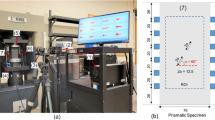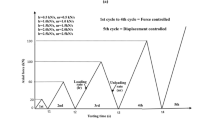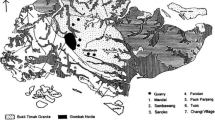Abstract
A series of stepwise cyclic tests and short-term creep tests were conducted on Beishan granite to quantify the separated effect of stress corrosion and friction degradation during cyclic loading. An opti-acoustic monitoring platform that combined digital image correlation and acoustic emission techniques was utilized to monitor the rock deformation and fracturing at both the micro- and macro-scale simultaneously. In addition, a micromechanical model was built to study the crack growth of rocks exposed to cyclic and creep loads. Experimental and theoretical results indicated that both the repeated and constant loads play a great role in deformation localization, micro-fracturing, and damage accumulation. A similar law was observed in the evolution of the AE b value and distribution of frequency-amplitude in granite under cyclic and creep loading. However, cyclic loads induced a greater AE count rate in granite than constant loads at low loading levels, while constant loads stimulated a greater AE count rate than cyclic loads at high loading levels. Moreover, cyclic loads promoted more strain localization bands than constant load; so, more macro-cracks, branching, and debris were observed in granite during cyclic loading. These similarities and differences indicated that both the stress corrosion and fatigue mechanisms were highlighted to be responsible for the sub-critical crack growth of rocks during cyclic loading. The development of sub-critical crack growth and the evolution of stress intensity factor at the crack tip within rocks under cyclic and constant loads were well described by the micromechanical theoretical model.
Highlights
-
Laboratory experiments were conducted to distinguish stress corrosion and reciprocating wear from rock fatigue.
-
Real-time observation of rock deformation and fracturing was achieved using opti-acoustic technology.
-
A micromechanical theoretical model was built to characterize the sub-critical crack growth in rocks.
















Similar content being viewed by others
Data availability
Data will be made available on request.
References
Aggelis DG, Mpalaskas AC, Matikas TE (2013) Acoustic signature of different fracture modes in marble and cementitious materials under flexural load. Mech Res Commun 47:39–43. https://doi.org/10.1016/j.mechrescom.2012.11.007
Anderson TL (1995) Fracture mechanics: fundamentals and applications[M]. CRC Press, London
Ashby MF, Sammis CG (1990) The damage mechanics of brittle solids in compression. Pure Appl Geophys 133:489–521
Attewell PB, Farmer IW (1973) Fatigue behaviour of rock. Int J Rock Mech Min Sci Geomech Abstr 10:1–9. https://doi.org/10.1016/0148-9062(73)90055-7
Bhat HS, Sammis CG, Rosakis AJ (2011) The micromechanics of westerley granite at large compressive loads. Pure Appl Geophys 168:2181–2198. https://doi.org/10.1007/s00024-011-0271-9
Brantut N, Baud P, Heap MJ, Meredith PG (2012) Micromechanics of brittle creep in rocks. J Geophys Res Solid Earth. https://doi.org/10.1029/2012jb009299
Cerfontaine B, Collin F (2017) Cyclic and fatigue behaviour of rock materials: review, interpretation and research perspectives. Rock Mech Rock Eng 51:391–414. https://doi.org/10.1007/s00603-017-1337-5
Chu Z, Wu Z, Wang Z, Weng L, Liu Q, Fan L (2022) Micro-mechanism of brittle creep in saturated sandstone and its mechanical behavior after creep damage. Int J Rock Mech Min Sci. https://doi.org/10.1016/j.ijrmms.2021.104994
Costin LS, Holcomb DJ (1981) Time-dependent failure of rock under cyclic loading. Tectonophysics 79:279–296. https://doi.org/10.1016/0040-1951(81)90117-7
David EC, Brantut N, Schubnel A, Zimmerman RW (2012) Sliding crack model for nonlinearity and hysteresis in the uniaxial stress–strain curve of rock. Int J Rock Mech Min Sci 52:9–17
Evans AG, Fuller ER (1974) Crack propagation in ceramic materials under cyclic loading conditions. Metall Mater Trans B 5:27. https://doi.org/10.1007/BF02642921
Fan J, Chen J, Jiang D, Chemenda A, Chen J, Ambre J (2017) Discontinuous cyclic loading tests of salt with acoustic emission monitoring. Int J Fatigue 94:140–144. https://doi.org/10.1016/j.ijfatigue.2016.09.016
GeranmayehVaneghi R, Ferdosi B, Okoth AD, Kuek B (2018) Strength degradation of sandstone and granodiorite under uniaxial cyclic loading. J Rock Mech Geotech Eng 10:117–126. https://doi.org/10.1016/j.jrmge.2017.09.005
Ghamgosar M, Erarslan N (2015) Experimental and numerical studies on development of fracture process zone (FPZ) in rocks under cyclic and static loadings. Rock Mech Rock Eng 49:893–908. https://doi.org/10.1007/s00603-015-0793-z
Liu E, He S (2012) Effects of cyclic dynamic loading on the mechanical properties of intact rock samples under confining pressure conditions. Eng Geol 125:81–91. https://doi.org/10.1016/j.enggeo.2011.11.007
Lyu C, Liu J, Ren Y, Liang C, Liao Y (2021) Study on very long-term creep tests and nonlinear creep-damage constitutive model of salt rock. Int J Rock Mech Min Sci. https://doi.org/10.1016/j.ijrmms.2021.104873
Miao S, Pan P-Z, Konicek P, Yu P, Liu K (2021) Rock damage and fracturing induced by high static stress and slightly dynamic disturbance with acoustic emission and digital image correlation techniques. J Rock Mech Geotech Eng 13:1002–1019
Miao S, Pan P-Z, Yu P, Hou W (2022) Fracture behaviour of two microstructurally different rocks exposed to high static stress and cyclic disturbances. Rock Mech Rock Eng. https://doi.org/10.1007/s00603-022-02810-1
Momeni A, Karakus M, Khanlari GR, Heidari M (2015) Effects of cyclic loading on the mechanical properties of a granite. Int J Rock Mech Min Sci 77:89–96. https://doi.org/10.1016/j.ijrmms.2015.03.029
Scholz CH, Koczynski TA (1979) Dilatancy anisotropy and the response of rock to large cyclic loads. J Geophys Res. https://doi.org/10.1029/JB084iB10p05525
Scholz CH, Kranz R (1974) Notes on dilatancy recovery. J Geophys Res 79:2132–2135. https://doi.org/10.1029/JB079i014p02132
Xiao J-Q, Ding D-X, Xu G, Jiang F-L (2009) Inverted S-shaped model for nonlinear fatigue damage of rock. Int J Rock Mech Min Sci 46:643–648. https://doi.org/10.1016/j.ijrmms.2008.11.002
Zhao K et al (2022) Creep-fatigue characteristics of rock salt under different loading paths. J Pet Sci Eng. https://doi.org/10.1016/j.petrol.2022.111036
Zoback MD, Byerlee JD (1975) The effect of cyclic differential stress on dilatancy in westerly granite under uniaxial and triaxial conditions. J Geophys Res 80:1526–1530
Acknowledgements
This work was supported by the National Natural Science Foundation of China (Grant No. 52125903).
Author information
Authors and Affiliations
Corresponding author
Ethics declarations
Conflict of Interest
The authors declare that they have no known competing financial interests or personal relationships that could have appeared to influence the work reported in this paper.
Additional information
Publisher's Note
Springer Nature remains neutral with regard to jurisdictional claims in published maps and institutional affiliations.
Rights and permissions
Springer Nature or its licensor (e.g. a society or other partner) holds exclusive rights to this article under a publishing agreement with the author(s) or other rightsholder(s); author self-archiving of the accepted manuscript version of this article is solely governed by the terms of such publishing agreement and applicable law.
About this article
Cite this article
Miao, S., Pan, PZ., Wang, Z. et al. Mechanism Interpretation of Sub-critical Crack Growth in Beishan Granite Subjected to Cyclic Loading. Rock Mech Rock Eng 56, 7777–7794 (2023). https://doi.org/10.1007/s00603-023-03467-0
Received:
Accepted:
Published:
Issue Date:
DOI: https://doi.org/10.1007/s00603-023-03467-0




